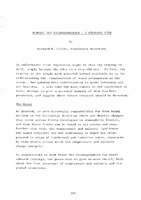| dc.contributor.author | Clarke, Richard H. | |
| dc.date.accessioned | 2018-10-11T14:06:45Z | |
| dc.date.available | 2018-10-11T14:06:45Z | |
| dc.date.issued | 1971/12 | |
| dc.identifier | 91 | |
| dc.identifier.govdoc | CP-5/2 | |
| dc.identifier.uri | http://hdl.handle.net/20.500.12489/293 | |
| dc.description.abstract | An unfortunate first impression might be that ray tracing is dull, simply because the idea is a very old one. In fact, ray tracing is the single most powerful method available to us for understanding the complexities of sound propagation in the ocean. And gaining this understanding is quite literally all our business. I will take the main topics of the conference in turn, attempt to give a personal summary of what has been presented, and suggest where future research should be directed. | |
| dc.format | 9 p. : ill. ; digital, PDF file | |
| dc.language | English | |
| dc.publisher | NATO. SACLANTCEN | |
| dc.source | In: SACLANTCEN Conference Proceedings No. 5 part 2, pp. 362-370 | |
| dc.subject | Ray tracing | |
| dc.subject | Acoustic propagation | |
| dc.subject | Underwater acoustics | |
| dc.title | Summary and recommendations | |
| dc.type | Papers and Articles | |
| dc.type | Conference Proceedings (CP) | |
